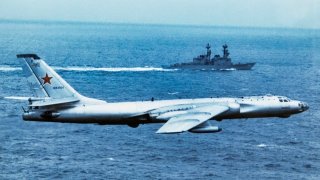Inside the Cockpit: A Tu-16 Bomber Crew's Harrowing Tale of Nuclear Testing
In 1962, Tupolev Tu-16 bombers executed two flight tactical exercises involving live drops of nuclear weapons, marking a significant moment in military history. Crew members recounted the overwhelming experience of the bomb's detonation, describing intense light and physical shockwaves.
Summary: In 1962, Tupolev Tu-16 bombers executed two flight tactical exercises involving live drops of nuclear weapons, marking a significant moment in military history. Crew members recounted the overwhelming experience of the bomb's detonation, describing intense light and physical shockwaves. The Tu-16, conceptualized in the 1940s to counter American strategic bombers, evolved into a versatile platform capable of carrying both nuclear and conventional weapons.
How Russian Tu-16 Bomber Crews Trained with Live Nuclear Bombs
As the Cold War carried on and the arms race between the U.S. and the Soviet Union ramped up, nuclear testing became more prominent. The Soviet Union tested its first nuclear weapon in 1949. Their detonation of the “First Lightning” bomb perhaps heightened America’s urgency to continue to research thermonuclear weapons. From 1955 to 1989, an average of 55 nuclear tests were carried out each year.
By 1961, the Soviets staged another nuclear test, this time involving a 50-megaton RDS-220 device given the moniker “Tsar Bomba.” One year later, Tupolev Tu-16 heavy bomber regiments carried out live drops of nuclear weapons.
The Story
On Sept. 15-16, 1962, the Tu-16 bombers conducted two flight tactical exercises involving two dozen airframes. One crew member later described his experience in the book Cold War Skies. He described what happened when the bomb was dropped:
“Suddenly, the brightest glow burst into the heavens, gilding the clouds. It illuminated all the space around us with intense light, which penetrated into the cockpit, scattering the shadows and illuminating the instruments.
“The light had a kick like a mule, for a few moments after it appeared we were shaken again and again, as if we were crossing a railway at high speed along a broken road. Dull blows shook the entire airframe, rattling our spines. The wings rocked, the nose twitched. On the instrument dials, the needles spun. We stroked the controls, comforting the aircraft, and once again she sailed obediently through the air.
“To the left of the smooth surface of the clouds, a huge white dome suddenly began to heave and grow rapidly. As soon as it formed into a hemisphere, it rose through the cloud layer, dragging behind it a wide smoke column, climbing rapidly to a huge height, already well above our own. And the top of it, a colossal turban of the gentlest tones of all the colors of the rainbow bathed in shimmering sunlight, hovering at an altitude of 20–30km. The entire regiment cruised around that turban as if in a circle of honor.”
Introducing the Tupolev Tu-16
The Tupolev was first conceptualized in the 1940s, when the Soviets desired a strategic bombing force that could counter American capabilities. The USSR depended heavily on its Tu-4 “Bull’ strategic bomber, which was essentially a reverse-engineered version of the U.S. Air Force’s B-29 Superfortress. Soviet engineers developed the new Mikulin AM-3 turbojet engine during this time period. That innovation made it possible to envision the development of a larger, jet-powered bomber like the Tupolev.
When the NATO-designated “Badger” bomber first entered service with the Soviet Union, it proved to be a highly versatile platform. The bomber could lug AS-1 missiles, which could be fitted with both nuclear and conventional warheads.
Modified variants of the Tu-16 were developed over time, specializing in a range of capabilities including maritime surveillance, aerial reconnaissance, electronic warfare, and electronic intelligence gathering.
In addition to its stint dropping a live nuclear bomb in the early 1960s, the Tupolev also participated in combat. The Indonesian Air Force employed Badgers during Operation Trikora. Later, these bombers were used against Israel during the 1973 Yom Kippur War, and against Libya a few years later in a border clash.
While the Tupolev is still technically in limited service, its last true combat experience was during the Iran-Iraq War in the 1980s.
About the Author: Maya Carlin
Maya Carlin, National Security Writer with The National Interest, is an analyst with the Center for Security Policy and a former Anna Sobol Levy Fellow at IDC Herzliya in Israel. She has by-lines in many publications, including The National Interest, Jerusalem Post, and Times of Israel. You can follow her on Twitter: @MayaCarlin. Email the author: [email protected].
Image Credit: Creative Commons.


